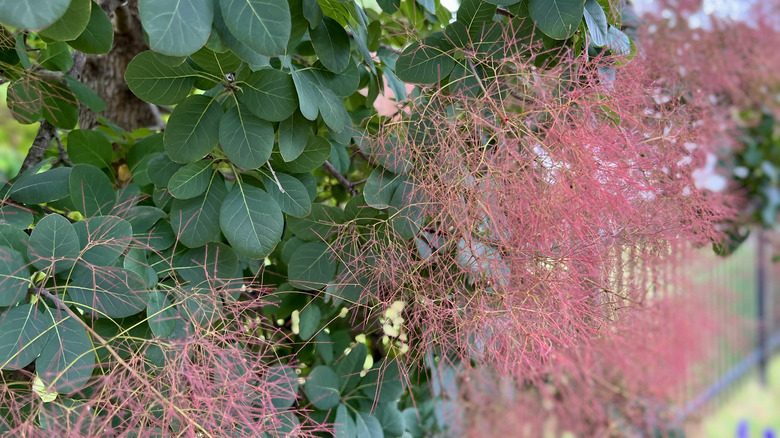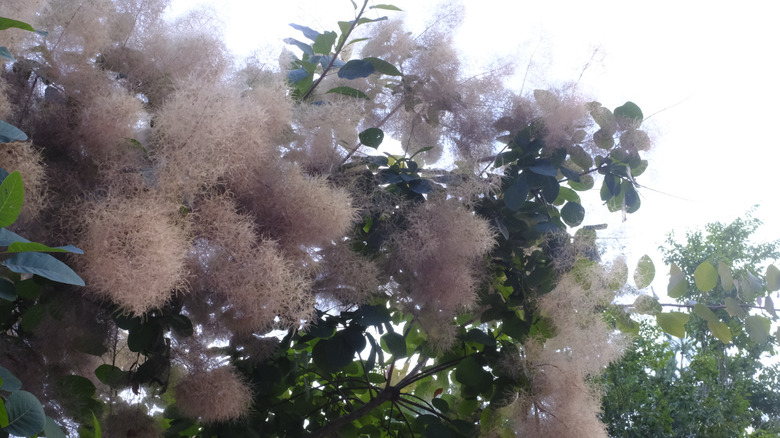How To Grow An American Smoke Tree Into A Bush For Gorgeous Patio Privacy
Even those blessed with respectful neighbors probably want to create some privacy in their outdoor space with budget-friendly solutions. And what can be more beneficial for the wallet and the planet than native plants — or, more specifically, the American smoke tree (Cotinus obovatus)? According to The U.S. Forest Service, the best use of this native tree is for patio privacy or as an accent and fencing shrub. It's hardy, likes most soils, and is undeniably pretty to look at. Despite all the positives, the American smoke tree comes with a caveat ... It needs pruning to keep it shrub-sized. Without it, it will grow rather more like the tree — albeit one on the smaller side — its common moniker suggests. Thankfully, that's an easier task than it sounds.
Some gardeners are probably familiar with a popular close cousin and American smoke tree look-alike, the Eurasian smoke tree (Cotinus coggygria). While similar in many ways, these plants differ in origin — the former is native to the southern U.S., while the latter was introduced to America in at least the mid-1600s. Both are in the Anacardiaceae family, along with sumac, the shrubby tree that the popular Middle Eastern spice of the same name comes from, and cashews.
Buying and caring for an American smoke tree patio border
Saplings are available from nurseries and tree farms specializing in native plants. Cultivars to consider include Cotton Candy American smoke tree (Cotinus obovatus 'Northstar'), with its dramatic, peach colored plumes, and Cotinus 'Grace', a hybrid of the European and American smoke tree with deep purple spring foliage. Whatever tree you decide upon, just remember that this species grows slowly. If you buy a sapling, you're going to have to be patient in your quest for patio privacy.
Learning how to care for a smoke tree, the American variety, is far easier than its Eurasian counterpart. Gardeners in USDA Hardiness zones 4 to 8 with heavy clay soils will rejoice: American smoke trees aren't fussy about where they take root, so long as it's in full sun. They like a good soaking, especially in times of drought, but won't tolerate boggy conditions or overly fertile soil. While the American smoke tree makes a great border shrub, it needs regular trims to perform as such. The tree flowers in May, so prune in early spring before the blooms appear or late fall after the panicles have receded. You can prune it fairly heavily in the winter, but don't cut the plant back too much or you might end up with no flowers next season. Keep an eye out for and treat immediately leaf spot, rust, verticillium wilt, and scale.
Why you should cultivate an American smoke tree privacy barrier
The American smoke tree is a shrub popular with city municipalities, and is often recommend for street plantings, such as under power lines and street lights. It also has benefits for homeowners seeking to create a solitudinous backyard. While it's definitely a tree, it won't get larger than 30 feet wide by 30 feet tall and its shallow, stringy root system means you won't have to worry about cracked concrete or patio pavers pushed up by exploratory rhizomes. This is a tree that lasts ages, too: You won't have to replace your privacy hedge for at least 60 years. Are you a passionate birder? Native plants are perfect for bringing birds to your yard; our feathered friends like to seek shelter and build nesting sites in American smoke trees. Oh, and did we mention the incredible display these trees put on in the fall? Expect an abundance of purple, orange, red, and yellow hues.
Of course, the American smoke tree isn't the magical elixir to all your privacy shrub woes. It does have some unappealing attributes. The sap contains a compound called urushiol, which is mildly toxic to the skin. When pruning, you'll need to don a pair of thick gloves. Cotinus obovatus is deciduous, meaning that in fall and winter, you'll need to get the rake out if you want a leaf-free outdoor area. The bark, while attractive, flakes off, making a mess of patio pavers or adjacent lawn.

